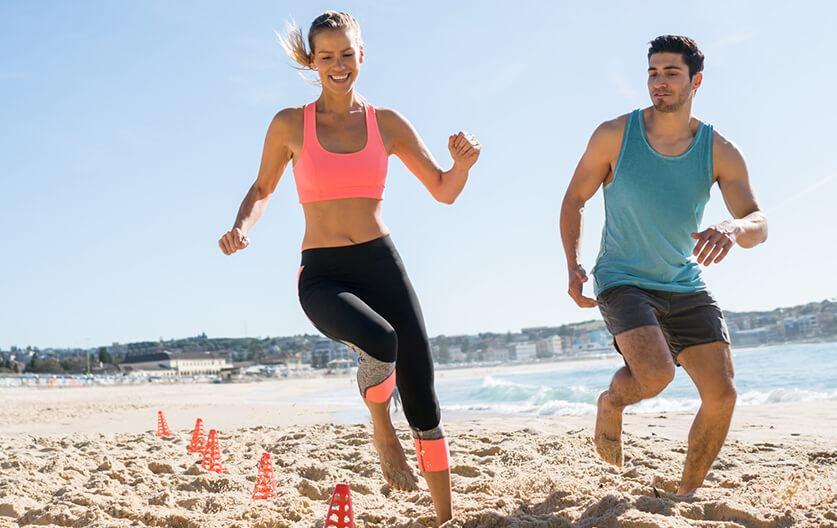- Home
- Mind & body
- How much should we be exercising?
At CBHS we help you manage your health challenges. We believe in offering you the services, support and tools you need to live your best life.
Our Better Living Programs are available to support eligible members towards a healthier lifestyle. Each Better Living Program is subject to its own eligibility criteria.
Contact us for more information and to confirm your eligibility for a program.
How much should we be exercising?

Why we need to exercise
Exercise benefits the physical and mental health of people of all ages.
As well as boosting our mood, regular physical activity reduces the risk of developing many serious illnesses including:
- heart disease
- diabetes
- depression
- lung disease
- dementia
- Alzheimer’s disease
Exercise also makes it easier to maintain a healthy body weight and can help us to manage existing conditions including arthritis and cancer. According to the Australian Institute of Health and Welfare, 55% of Australian adults are not meeting the physical activity guidelines and 67% of Australian adults were either overweight or obese in 2017-2018. In the same year, almost 25% of Australian children aged between five and 17 were also overweight or obese.
Children and young people
The Australian Physical Activity and Sedentary Guidelines recommend the following:
- birth to one year – regular moving on the floor from birth
- one to five years – at least three hours of physical activity each day
- five to 12 years – at least one hour of moderate to vigorous physical activity each day and several hours of light physical activity
- 13 years to 17 years – at least one hour of moderate vigorous physical activity each day and several hours of light physical activity
Vigorous activities are those that strengthen muscle and bone and children aged five to 17 should do these at least three days each week.
Healthdirect Australia outlines the many benefits of exercise for children including:
- developing healthy bones, muscles and joints
- improving balance and posture
- improving strength and muscle control
- maintaining a healthy weight
- developing social and teamwork skills
Adults
The Australian Physical Activity and Sedentary Guidelines recommend adults aged 18-64 years are:
- active on most, preferably all days each week
- do between 150 to 300 minutes of moderate intensity physical activity or 75 to 150 minutes of vigorous intensity physical activity each week
- do muscle strengthening activities on at least two days each week.
Regular physical activity can help adults manage:
- stress
- body weight
- blood cholesterol
- blood sugar
- blood pressure
Older adults
The Australian Physical Activity and Sedentary Guidelines recommend adults aged 65 years and older:
- do some physical activity no matter their age, weight, health problems or abilities
- should be active each day in as many ways as possible
- should accumulate at least 30 minutes of moderate intensity physical activity on most, preferably all days
If you’re new to exercise or haven’t been that active recently, it’s important to gradually build up your exercise over time.
You can read more about exercise tips for older Australians at the Department of Health.
Regular physical activity can help older adults to maintain:
- muscle strength
- bone density
- joint health
- healthy body weight
- lung and heart health
Tips for getting active
If you’re just starting out with a new exercise program, it’s important that you start out slowly and gradually build up your exercise levels over time.
You should also choose an activity that you enjoy and will look forward to.
It’s also a good idea to set measurable short-term and long-term goals. For example, setting goals of walking an extra 20 minutes each day, rather than just becoming more active.
You can read more tips for getting active at Healthdirect Australia.
Sources
https://www.betterhealth.vic.gov.au/health/healthyliving/physical-activity-its-important
https://www1.health.gov.au/internet/main/publishing.nsf/Content/sbehaviour
https://www.healthdirect.gov.au/tips-for-getting-active
https://www.healthdirect.gov.au/blog/3-ways-exercise-changes-lives
https://www.healthdirect.gov.au/benefits-of-physical-activity-for-children
https://www.health.gov.au/health-topics/exercise-and-physical-activity
https://www.aihw.gov.au/reports-data/behaviours-risk-factors/physical-activity/overview
All information contained in this article is intended for general information purposes only. The information provided should not be relied upon as medical advice and does not supersede or replace a consultation with a suitably qualified healthcare professional.
Health and wellbeing
programs & support
You Belong to More with CBHS Hospital cover:
- Greater choice over your health options including who treats you
- Get care at home with Hospital Substitute Treatment program
- Free health and wellbeing programs to support your health challenges
Live your healthiest, happiest life with CBHS Extras cover:
- Benefits for proactive health checks e.g. bone density tests, eye screenings
- Keep up your care with telehealth and digital options
- Save on dental and optical with CBHS Choice Network providers
